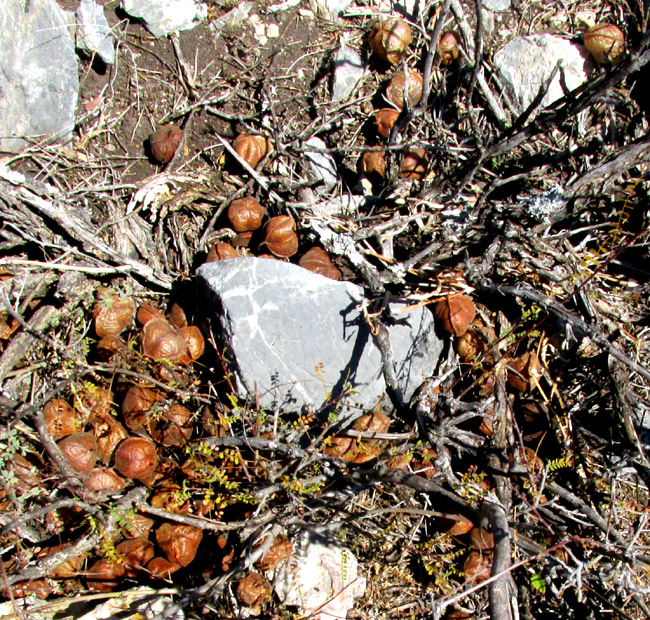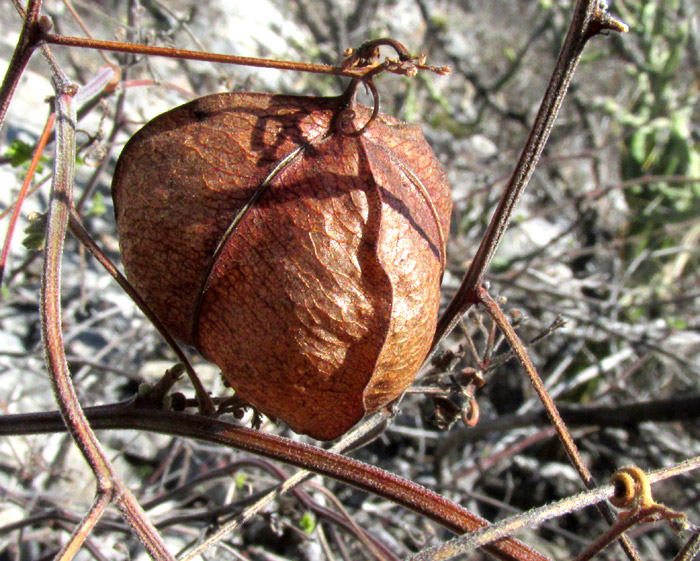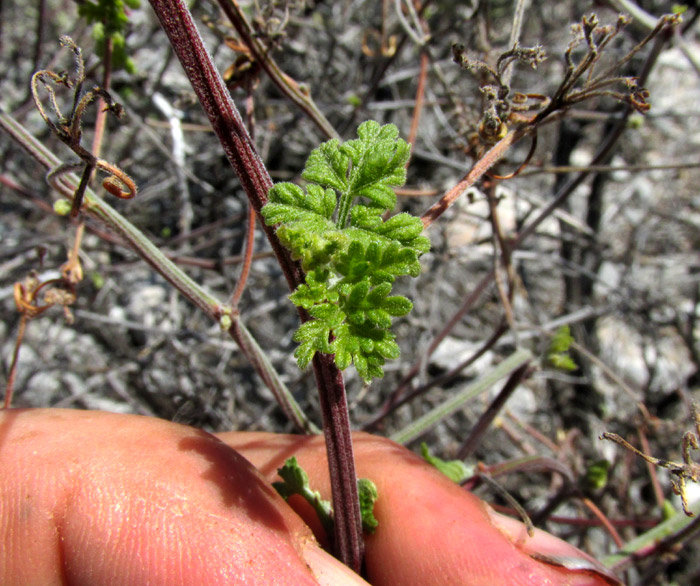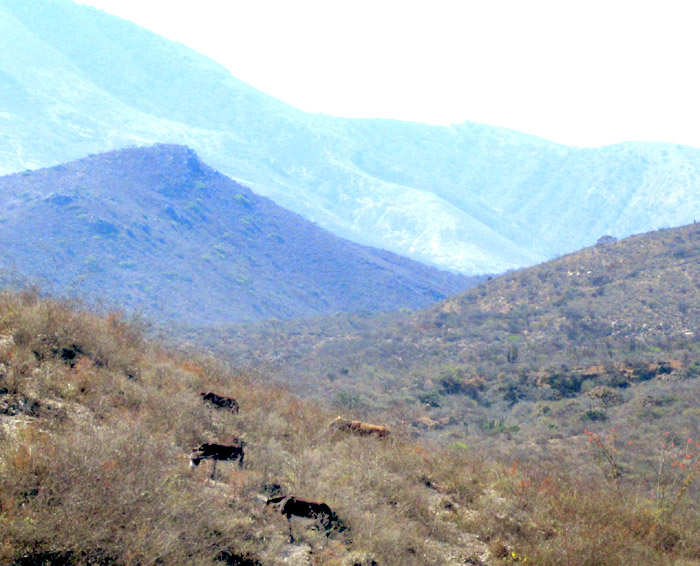Excerpts from Jim Conrad's
Naturalist Newsletter
Entry dated March 10, 2024, from notes taken about 2kms west of Higuerillas, Municipality of Cadereyta de Montes; N20.9086°, W99.7865°, elevation ~1760 meters (~5760 feet); on greywacke sandstone cap of hill; area constituting a narrow belt of the extreme southern extension of the Chihuahuan Desert, Meridional Subregion; central Querétaro state, MÉXICO
BALLOON VINE DROPPING FRUITS

In these isolated mountains where small bands of feral burros wander around eating whatever they can, at first glance I thought the above was a pile of burro poop somehow deposited in the center of a low-growing, spiny mimosa bush. But then this was noticed:

It's the late-season, brown, capsule-type fruit of a Balloon Vine, CARDIOSPERMUM HALICACABUM, a species apparently native to the tropics and subtropics worldwide, and often extending into the world's temperate zones. Above, at the picture's lower, right corner a stem's tendrils tightly wrap around another stem. At the top, left, the capsule's peduncle arises from yet another stem. All stems and branches of various species all around were dry-season leafless.

Above, a broken apart capsule shows how the balloon-like fruit is divided into three partitions. A single spherical, black seed occupies each compartment. When the fruits fall to the ground, they can be blown by wind to new locations, where new vines may establish.

Last season's leaves have fallen, but above we see two freshly emerging compound leaves. Each leaf consists of three leaflets, and each leaflet is deeply lobed -- the leaf is biternately compound. Finally, here's the setting in which the above vine lives, along with feral burros and a roving cow somehow surviving in the parched landscape:

Balloon Vine's scientific name, Cardiospermum halicacabum, was bestowed by Linnaeus himself back in 1753. It has a long history of uses as a medicinal plant worldwide. The 2022 study by Abbirami Elangovan and others entitled "Ethnomedical, phytochemical and pharmacological insights on an Indian medicinal plant: The balloon vine (Cardiospermum halicacabum Linn.)", concluded that "... C. halicacabum showed a broad spectrum of pharmacological activities including anti-inflammatory, anti-arthritic, anti-diabetic, anxiolytic activity, antiulcer, apoptotic activity, antibacterial, antiviral, anti-diarrheal, antioxidant, hepatoprotective, and nephroprotective properties."
Traditional uses are too many to list. The online Atlas de las Plantas de la Medicina Tradicional Mexicana reports that in the Mexican state of Michoacán the vine is used for treating diarrhea, and in the state of México, for eye problems. In Durango state it cures tacotillos, which are small grainlike things embeded in the skin, especially around the anus.
Beyond that, the 2012 work by M. Govindarajan and R. Sivakumar entitled "Adulticidal properties of Cardiospermum halicacabum plant extracts against three important vector mosquitoes," found that extracts from the vine killed adult mosquitoes; "... C. halicacabum was an excellent potential for controlling Cx. quinquefasciatus, Ae. aegypti and An. stephensi mosquitoes."
Perdue University's "Famine Foods" page reports that Cardiospermum halicacabum leaves, young shoots and fruit rind can be cooked and eaten.
The following entry, from 2007, shows the immature capsules
from the September 21, 2007 Newsletter issued from Sierra Gorda Biosphere Reserve, QUERÉTARO, MÉXICO
BALLOON-VINES
Climbing into the mesquites was a vine with trifoliate leaves and eye-catching fruits, which you can see below:

This is CARDIOSPERMUM HALICACABUM, called Balloon-vine in English, a member of the Soapberry Family, the Sapindaceae, a family not well represented beyond the tropics. Another species you might know in the family is the Golden-rain-tree from Asia, sometimes planted as a street tree and also producing papery-walled fruits.
In the picture I'm holding one of the Balloon-vine's fruit pods from which one side has been removed so you can see how the immature seed is suspended inside the bladder. This is a beautiful example of how a fruit can be adapted for wind dispersal. Bladders fall to the ground, perhaps being blown a good distance from the vine as they fall, then wind can roll them even farther.
Balloon-vines are native to tropical America but it's planted in northern climes where it dies back each winter, and is considered an annual ornamental. In Mississippi it was a weed in my garden and climbed lustily along fences.